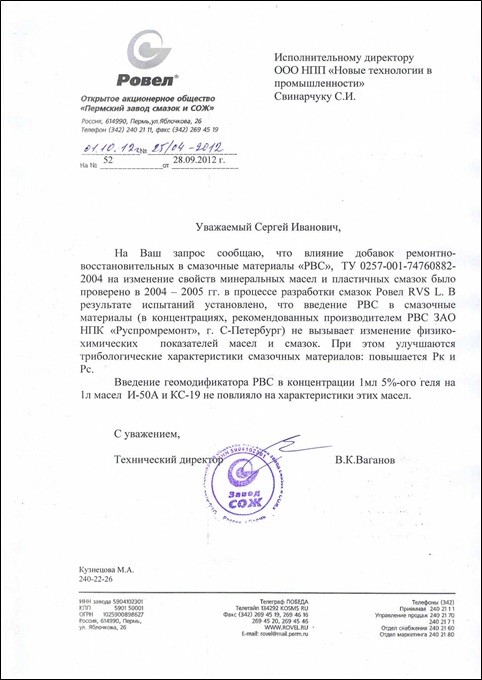ATTENTION!
Repair-Restoration Compounds are not common soluble additives in oils.
The objects of RRC impact are friction surfaces, not lubricants!
Below is the letter translation of Open Joint-Stock Company «Perm Lubricants and Lubricoolants Plant» 25/04-2012 01.10.12
For the executive director of «New technologies in industry» Ltd scientific and production enterprise Svinarchuk S. I.

28.09.2012
Dear Sergey Ivanovich,
Upon your request, I inform you that the impact of repair-restoration additions «РВС», TS 0257-001 -74760882-2004 on the change in the properties of mineral oils and plastic grease was checked in 2004-2005 during the development of lubricants Rovel RVS L. As a result of tests, it was established that the introduction of RRC into lubricants (in concentrations recommended by the manufacturer of RRC CJSC NPC «Ruspromremont», St. Petersburg) does not cause a change in the physical and chemical parameters of lubricant oils and plastic grease. At the same time, tribological characteristics of lubricants are improved: critical load and welding load are increased.
The introduction of the PBC geomodifier at a concentration of 1 ml of 5% gel 1 l oils I-50A and KS-19 did not affect the characteristics of these oils.
Kind regards,
Technical Director
V.K. Vaganov
Differences between RRC and additives are as follows:
– RRC act only on friction surfaces in places of their contacts;
– RRC improve the working conditions of friction pairs made of ferrous and non-ferrous metals, their alloys and composite materials;
– after the use of the RRC when replacing lubricants in accordance with the maintenance procedure, the mandatory re-introduction of the RRC is not required.






